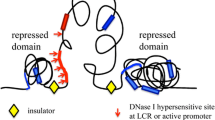Summary
The human genome contains about 3×109 base pairs which, based on average estimates for the size of coding regions, might suggest an upper limit of about 3 million genes. Evidence from a variety of approaches indicates a much lower figure — in the range 40 000–100 000 genes. Renaturation kinetic analysis reveals the presence of many repetitive elements in the human genome. Some of these are quite simple and highly reiterated, others are more complex and exist in fewer copies. The distribution and function of some of these families and the evolution of complex genomes from simpler ones are discussed.
Similar content being viewed by others
References
Antequera F, Bird A (1993) DNA methylation and CpG islands. In Heslop-Harrison JS, Flavell RB, eds.The Chromosome, BIOS Scientific Publishers, 127–133.
Blackburn EH (1992) Telomerases.Annu Rev Biochem 61: 113–129.
Britten RY, Baron WF, Stout DB, Davidson EH (1988) Sources and evolution of humanAlu repeated sequences.Proc Natl Acad Sci USA 85: 4770–4774.
Craig IW, Craig SP (1991) Genomic distribution of coding sequences homologous to those on chromosome 12.Cytogenet Cell Genet 58: 1851–1852.
Craig IW, McBride OW (1991) Report of the committee on the genetic constitution of chromosome 12.Cytogenet Cell Genet 58: 555–579.
Dombroski BA, Mathias SL, Nanthakumar E, Scott AF, Kazazian HH Jr (1991) Isolation of an active human transposable element.Science 254: 1805–1808.
Fraser NJ, Boyd Y, Craig IW (1988) Isolation and characterisation of a human variable copy number tandem repeat at Xpcen-11.22 with potential to form a cruciform structure.Genomics 5: 144–148.
Goldman MA, Holmquist GP, Gray MC, Nag A (1984) Replication timing of genes and middle repetitive sequences.Science 224: 686–689.
Haldane JBS (1957)J Genet 55: 511–524.
Hendriks RW, Chen Z-Y, Hinds H, Schuurman RKB, Craig IW (1992) An X chromosome inactivation assay based on differential methylation of a CpG island coupled to a VNTR at the 5′ end of the monoamine oxidase A gene.Hum Mol Genet 1: 187–194.
Jeffreys AJ (1987) Highly variable minisatellites and DNA fingerprints.Biochem Soc Trans 15: 309–317.
Jeffreys AJ, Flavell RA (1990) The rabbit beta-globin gene contains a large insert in the coding sequence.Genomics 77: 1–11.
Korenberg JR, Rykowski MC (1988) Human genome organisation: Alu, Lines and the molecular structure of metaphase chromosome bands.Cell 53: 391–400.
Levinson B, Kenwrick S, Lakich D, Hammonds G Jr, Gitschier J (1990) A transcribed gene in an intron of the human factor VIII gene.Genomics 7: 1–11.
Matsumuto H, Masukata H, Muro Y, Nozaki N, Okasaki T (1989) A human centromere antigen (CENP-B) interacts with a short, specific sequence in alphoid DNA, a human centromeric satellite.J Cell Biol 109: 1962–1973.
Maynard-Smith J (1968)Nature 219: 1114–1116.
Meitinger T, Fraser NJ, Lorenz B, Zrenner E, Murken J, Craig IW (1989) Linkage of X-linked retinitis pigmentosa to the hypervariable DNA marker M27B (DXS255).Hum Genet 81: 283–286.
Nelson DL, Warren ST (1993) Trinucleotide repeat instability: when and where?Nature Genetics 4: 107–108.
Oliver SG, Aart QJM van der, Agostoni-Carbone ML et al (1992) The complete DNA sequence of yeast chromosome III.Nature 357: 38–46.
Pardue ML, Gall JG (1970) Chromosomal localisation of mouse satellite DNS.Proc Natl Acad Sci USA 168: 1356–1358.
Singer M (1982) Highly repeated sequences in mammalian genomes.Int Rev Cytol 76: 67–112.
Weber JL, May PE (1989) Abundant class of human DNA polymorphisms which can be typed using the polymerase chain reaction.Am J Hum Genet 44: 388–396.
Weissenbach J, Gyapay G, Dib C et al (1992) A second generation linkage map of the human genome.Nature 359: 794–801.
Zhang Y, Shields T, Crenshaw T, Hao Y, Moulton T, Tycko B (1993) Imprinting of human H19: allele-specific CpG methylation, loss of the active allele in Wilms tumor, and potential for somatic allele switching.Am J Hum Genet 53: 113–124.
Author information
Authors and Affiliations
Rights and permissions
About this article
Cite this article
Craig, I.W. Organization of the human genome. J Inherit Metab Dis 17, 391–402 (1994). https://doi.org/10.1007/BF00711355
Issue Date:
DOI: https://doi.org/10.1007/BF00711355




